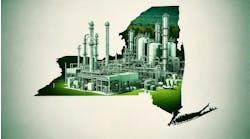Last month we discussed fired equipment (furnaces and boilers) and factors that affect their energy efficiency (see: “Get Fired Up”). Here, we turn to ways to maintain and improve that efficiency. With many different types of furnaces and boilers available, this generic discussion may not apply equally to all of them.
Most large modern industrial furnaces can achieve a net (LHV) efficiency of 94% or more. This is a significant improvement over furnaces designed in the 1960s and early 1970s, which generally had net efficiencies below 90%. It stems from numerous improvements in materials and design, including:
- Higher firebox temperatures, which increase heat intensity. This is achieved with the aid of more-resilient tube-metal alloys.
- Lower stack temperatures, obtained by increasing the size of the convection section. This often requires adding induced draft fans to offset the increased gas flow resistance created by the larger convection bank. If the stack gas is to be cooled below its acid dew point, resisting acid corrosion will call for expensive materials — e.g., special alloys, glass or enamel coatings, or advanced polymers.
- Better insulation materials and thicker refractories to reduce heat losses through the casing.
- Improved sealing of the furnace casing and better burner control, leading to lower excess air.
No matter how good its design, a furnace or boiler must be well maintained to sustain its efficiency over time. The following are important examples.
- Contaminants in the fuel often lead to burner tip plugging, which adversely affects combustion efficiency. Maintenance personnel should inspect the burner daily, tag dirty burners, and clean the tips as required. In addition to improving energy efficiency, this also reduces NOx emissions.
- Fireboxes operate under negative pressure, so any openings will lead to ingress of cold tramp air, which must be minimized. Key to this is proper sealing of gaps in the casing. This includes tube penetrations, tube supports, and guide pins, as well as covers, gaskets, and peep doors.
- Over time, dust and debris collect in convection banks, especially on finned tubes. This reduces heat transfer, increases stack temperature, and lowers energy efficiency. Periodic cleaning is needed to correct this.
- Repeated temperature cycling can cause gaps to form between refractory modules. This increases heat losses, and creates “hot spots” on the casing. If these are not dealt with promptly the casing can buckle, leading to further damage. Inspect the refractory and make minor repairs as required during every outage.
Several opportunities exist to improve less-efficient furnaces and boilers. These include, but are not limited to, the following:
- If a boiler or furnace isn’t equipped with an online oxygen analyzer, it often is very cost-effective to add one, together with automatic trim control, to minimize excess air. Some analyzers also measure combustibles or carbon monoxide, NOx and other chemicals to ensure complete combustion for environmental compliance purposes. (See: “Optimize Combustion Using a Digital Twin.")
If the stack temperature is high, even when the existing convection bank is clean, consider additional heat-recovery equipment. Options include adding heat recovery coils to an existing convection bank, or installing an additional convection bank in a furnace, or placing an economizer (feedwater heater) in a boiler. Another possibility is adding an air preheater to heat combustion air against stack gas. However, this isn’t usually economic as a revamp project.
Boilers, and also furnaces that generate steam, have an additional inefficiency associated with blowdown. Blowdown causes losses of both water and energy; it increases the cost of producing steam. Common steps to mitigate these losses include:
- Route the blowdown through a flash vessel. The flash steam can go either to a low-pressure header or directly to a deaerator, while the liquid phase goes to a drain.
- Add a heat exchanger to transfer heat from the blowdown into boiler feedwater or some other heat sink.
- Upgrade the boiler feedwater water treatment system to remove more of the incoming dissolved solids, and thus reduce the amount of blowdown required.
Additional information:
Alan Rossiter & Beth Jones, “Energy Management and Efficiency for the Process Industries,” AIChE/John Wiley & Sons, Inc., Hoboken, New Jersey, 2015, Chapter 9.



